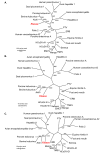Klassevirus 1, a previously undescribed member of the family Picornaviridae, is globally widespread
- PMID: 19552824
- PMCID: PMC2706813
- DOI: 10.1186/1743-422X-6-86
Klassevirus 1, a previously undescribed member of the family Picornaviridae, is globally widespread
Abstract
Background: Diarrhea is the third leading infectious cause of death worldwide and is estimated to be responsible for approximately 2 million deaths a year. While many infectious causes of diarrhea have been established, approximately 40% of all diarrhea cases are of unknown etiology. In an effort to identify novel viruses that may be causal agents of diarrhea, we used high throughput mass sequencing to analyze stool samples collected from patients with acute diarrhea.
Results: Sequences with limited similarity to known picornaviruses were detected in a stool sample collected in Australia from a child with acute diarrhea. Using a combination of mass sequencing, RT-PCR, 5' RACE and 3' RACE, a 6383 bp fragment of the viral genome was sequenced. Phylogenetic analysis demonstrated that this virus was highly divergent from, but most closely related to, members of the genus Kobuvirus. We have tentatively named this novel virus klassevirus 1. We also detected klassevirus 1 by RT-PCR in a diarrhea specimen collected from a patient in St. Louis, United States as well as in untreated sewage collected in Barcelona, Spain.
Conclusion: Klassevirus 1 is a previously undescribed picornavirus that is globally widespread and present on at least three continents. Further investigations to determine whether klassevirus 1 is a human pathogen are needed.
Figures


References
-
- World Health Report 2004. World Health Organization, Geneva, Switzerland; 2004.
-
- Chabra A, Chavez GF, Taylor D. Hospital use by pediatric patients: implications for change. Am J Prev Med. 1997;13:30–37. - PubMed
Publication types
MeSH terms
Substances
Associated data
- Actions
- Actions
- Actions
- Actions
- Actions
- Actions
- Actions

